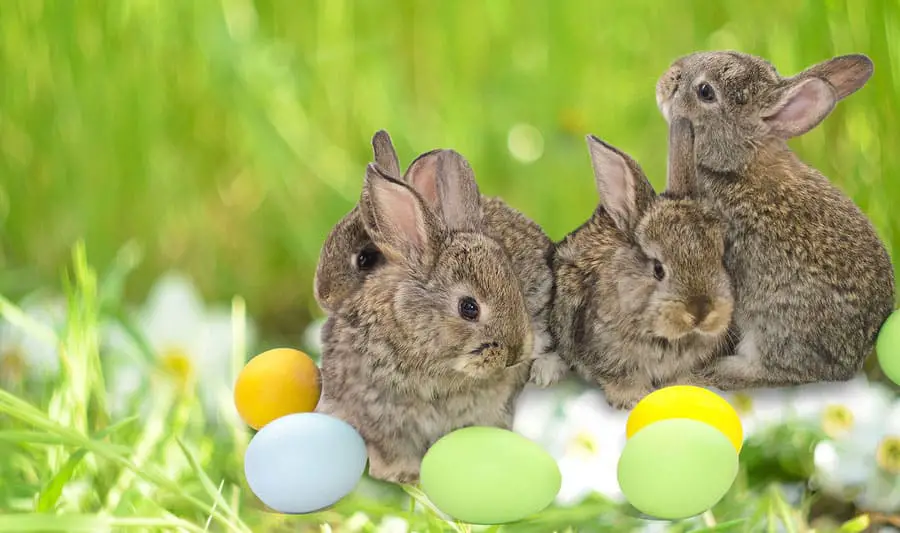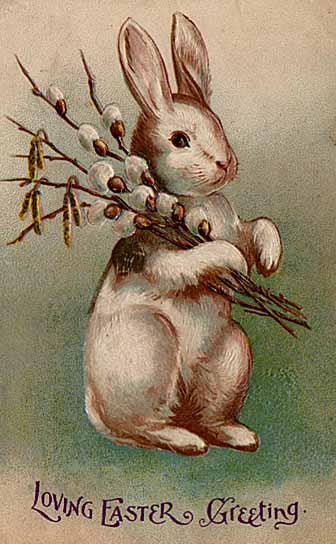Disclosure: We may earn money or products from the companies mentioned in this post.

I grew up in the country and from my earliest memories, my family has had rabbits. Having baby bunnies around has always been exciting times, and with this first-hand experience, I promise you that I know how rabbits have babies.
Do Bunnies Lay Eggs?
If you are wondering if rabbits lay eggs, let us be very clear: Rabbits do not lay eggs. Like most mammals, baby rabbits develop as embryos inside their mother’s uterus until they are developed enough to survive in the outside world when they are birthed in litters of peanut-sized baby rabbits.
But there is more to the story about egg-laying rabbits!
Let’s dig into where this Easter Bunny story came from and why he has anything to do with eggs, then let’s get the facts about how rabbits actually have babies.
Finally, I’ll shock you with a few mammals that actually do lay eggs.

The Origin Of The Story Of Rabbits Laying Eggs
It seems that the idea of an egg-laying rabbit was brought to America by German Lutheran immigrants in the 1700s who settled in Pennsylvania and become part of what would be known as the American Pennsylvanian Dutch Community.
In their Easter traditions, children would leave out their hats on the night before Easter with hopes that the egg-laying rabbit known as “Oschter Haws” (which translates to Easter Hare) would come by and judge them as good children.
In the morning the children would rush out to find what the Easter Bunny had left for them.
Good children would find brightly colored eggs and other treats, while those children judged to be less worthy would find in their hats what we all would expect to find after a rabbit visited…rabbit poop.
You can learn more about these Pennsylvanian Dutch Traditions in the book “Eastertide in Pennsylvania: A Folk-cultural Study” by Alfred Lewis. When this article was published, it was available for free as a Kindle Unlimited Book on Amazon.
The exact origin of the German Oschter Haws is lost in the fog of history.
Many scholars believe that the egg-laying bunny originated with the ancient festival of Ēostre or Ostara which was a festival celebrating the Spring Equinox and was a celebration of the coming spring, rebirth, and fertility.
With a focus on birth and fertility, I think we can pretty easily see why both rabbits and eggs might have been a central part of their ancient celebrations.
As you know, rabbits breed like…rabbits (if you’d like to learn more about how many rabbits a doe can have, I wrote an article about it).
And what else can you hold in your hand that promises rebirth more strongly than an egg?
With their shared ties to rebirth and fertility, combining rabbits and eggs seem like the perfect mashup for a spring festival.
Regardless of the origin of the Easter Bunny, our Egg-Laying Bunny Buddy has become a wonderful and fun tradition that I’m glad was part of my childhood and will still be part of my grandchildren’s springs.
But Where Did the Easter Bunny’s Decorated Easter Eggs Come From?
The colorful decorations on Easter Eggs are perhaps even more ancient than the idea of an egg-laying rabbit, with examples of decorated eggs being found in ancient Egypt, as well as in Greek, Persian, and Roman ruins.
There are even examples of decorated eggs to celebrate the first day of spring from Persia in 3000 BC!
Throughout recorded history, spring celebrations included decorated eggs in countless civilizations the world over.
At no time did decorate spring eggs become more elaborate than those created for the Imperial Russia Tsars Alexander III and Nicholas II as Easter gifts between the years of 1885 and 1917.
These amazing Easter Eggs were encrusted with gold, silver, and jewels. Each was created by Peter Carl Fabergé and they are still known by his name, the Fabergé Eggs.
In total, 52 Imperial Fabergé Eggs were created, and 46 survive to this day.

The Worlds Most Expensive Easter Egg?
In 2014, the Third Imperial Fabergé Egg is one of the oldest Imperial Fabergé Eggs and it was lost for nearly 100 years after the Russian Revolution in 1917.
However, it resurfaced in 1964 in America. Since then it’s been sold to a private collector for an undisclosed amount.
How expensive is the most expensive Easter Egg in the world?
The Third Imperial Fabergé Egg is estimated to be worth $33 Million Dollars, making it the most expensive Easter Egg in the world.
How Do Rabbits Actually Have Babies?
All mammals can be sorted into three groups in regards to how they reproduce.
- Placental Mammals
- Marsupial Mammals
- Monotreme Mammals
Rabbits are placental mammals, meaning that their babies develop inside their mother’s body until their body systems can function on their own.
Though rabbits young may be born fully formed, that does not mean that they can fend for themselves from the get-go. Bunny rabbits have an extremely short gestation period of only 31 days and as a result, need their mother’s presence almost constantly for the first few weeks.
Along with an extremely short gestation period rabbits reproduce using a system called induced ovulation. This means that rabbits release an egg from the ovary during sex and therefore can get pregnant very soon after birth, though normally rabbits are bred closer to 4 times a year.
If you’d like to learn more about how many litters a rabbit can have, here is an article I wrote on that subject.
What Mammals Actually Do Lay Eggs?
While rabbits don’t lay eggs, there are some mammals that really do lay eggs!
These unique animals fall in the third group of animals, Monotreme Mammals.
Monotremes really are crazy mammals, in some way having more in common with reptiles than the rest of us mammals.
For example, their body temperature is significantly lower than other mammals which are all warm-blooded. Their body temperature is much closer to that of cold-blooded reptiles.
And, of course, they lay eggs like reptiles!
There are only two kinds of monotremes alive today, though in the ancient past we believe there were many more that are now extinct.
The egg-laying mammals that still exist are:
- The Spiny Anteater or Echidna
- The platypus
As you can see, sadly there is no Easter Bunny on that list.
They both live in Australia, Tasmania, and New Guinea.
You’d think that the last two egg-laying mammals would lay eggs in about the same way, but they don’t!
The Spiny Anteater lays its eggs directly into a pouch where the eggs hatch while the platypus lays its eggs in an underground nest.
Wrapping Up The “Rabbits Lay Eggs” Myth
While it’s a fun story and great family fun, the tradition of the Egg-Laying Easter bunny is nothing more than a myth.
Still, it’s a myth that we can enjoy with our children and grandchildren, and as they get older we can share the history behind the beloved rabbit eggs, and introduce them to Easter Bunny’s egg-laying mammal cousins who really do exist!
~Stacey
